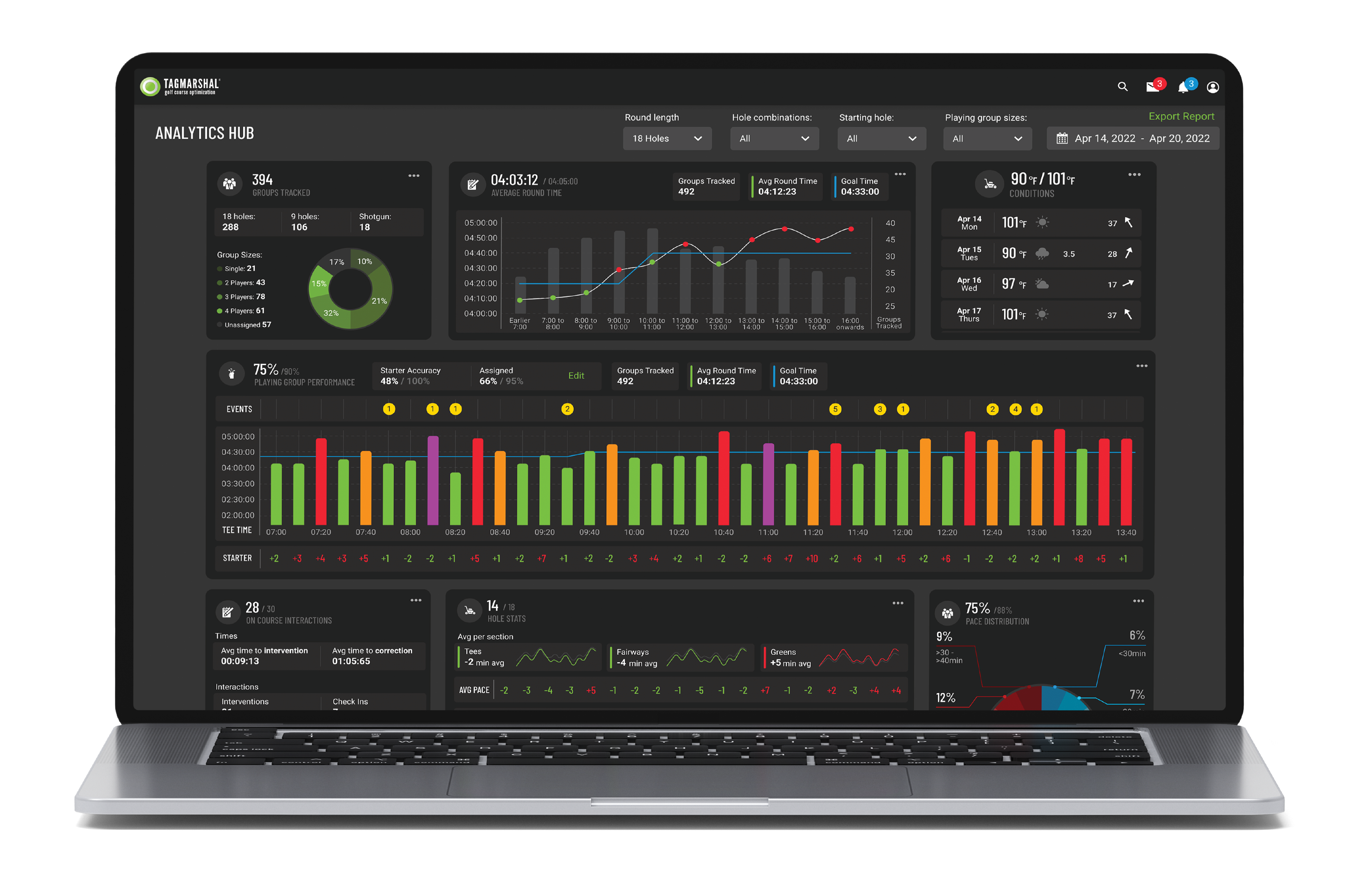Golf Cart GPS Systems: Daily Fee Courses Vs Private Courses: A Tagmarshal Comparison
Behind every successful golf course lies a meticulous operation, with golf cart GPS systems serving as a powerful way to stay on top of things. Whether it’s a public/daily fee course or an exclusive private club, the playbook that they operate by can differ significantly. And though they share the same objective of creating great player experiences while remaining profitable, they each face unique challenges in their mission.
Despite their different priorities, which we will unpack in detail further down, both types of courses rely on smart operational systems to ensure that they reach their goals. Tagmarshal is an industry-leading technology that can bridge the gap between the objectives of the course and player expectations in either setting.
In this article, we take a look at all the differences between daily fee courses and private courses, and how beneficial golf cart GPS systems can be to both.
Golf Cart GPS Systems: General Differences Between Daily Fee And Private Courses

When considering the differences between a daily fee course and a private course, a good starting point is their definitions. A daily fee course is generally a privately owned and operated course that is open to the public, with golfers required to pay a fee to play. Not to be confused with municipal courses, daily fee courses are not owned by a local authority; the pay-per-round fees are usually higher, owing to better course conditions and amenities.
Private courses, on the other hand, require a membership to gain access to the course or any of its amenities. This means that the course and the facilities are exclusive to members of the club and their guests, depending on the membership type and/or its rules. Memberships often require initiation fees as well as ongoing fees throughout the term of the membership. Again, this can differ from course to course and the membership type.
In a direct comparison, daily fee courses generally focus on increasing the day-to-day volume and turnover of golfers to frequent the course. In contrast, private clubs tend to focus on acquiring new members and retaining existing ones for a long period. Thus, member satisfaction is a key focus area in this model. These contrasts naturally lead to differences in the overall atmosphere at each course, as well as the demographics of the players who visit, which results in differences in how each is operated from a business perspective.
Golf Cart GPS Systems: Different Focus Areas Of Each Type Of Course
Seeing that each type of golf course has different revenue sources, its operations to generate those revenues can vary significantly. This means that the daily fee courses and private courses’ focus will be on different aspects of running the course or club. In this section, we’ll take a closer look at the specifics of each.
Daily Fee Course
At a daily fee course, the course is reliant on the consistent foot traffic (and the expenditure that comes with it) of players visiting the course daily. The bulk of this revenue is made up from green fees, rentals in golf clubs and/or golf carts, as well as food and beverage. It’s key for daily fee courses to try and get as many players to play on a day-to-day basis.
Since these courses rely on high player throughput, running the course efficiently, keeping rounds moving, and maximizing tee sheet capacity become paramount, as long as they all work in harmony. Like with any business, a course’s reputation and good reviews are what drive new and repeat players, who ultimately fund the course’s operations.
Private Course
While private courses may also benefit from things like rentals and food and beverage proceeds in the short term, these streams are not their main focus areas to generate revenue from. A private course’s top priority is to ensure the overall satisfaction of its members, which comes in a variety of ways. To achieve this, the focus is shifted towards experience, gaining loyalty, exclusivity, and providing value comprehensively.
As private courses aren’t trying to make as much money as possible per day, they are not as concerned about maximizing tee times or selling green fees, but rather retaining members by providing exceptional service and exclusive amenities. The goal here is to retain members over the long term (several years), rather than see short-term spikes. Their success largely depends on relationships and reputation as opposed to a daily turnover.
Different Expectations From Golfers

Unsurprisingly, with two such contrasting golfing environments, the players who frequent them would have very different expectations for each. Golfers who play at daily fee courses primarily look for convenience, good value, and simple access. This doesn’t mean they expect lower standards, but they understand that high-end luxuries are not always necessary.
In contrast, private club members expect their courses and reception to always be elite, luxurious, and with a dash of personalization. With the price tags that are often involved (we’ll be looking at cost differences next), it is clear to see why this, as well as the sense of belonging, is so highly regarded. Private club members expect near-perfection in every aspect, something you will likely not find at most daily fee courses.
These different expectations can lead to different outcomes in each setting, but the same relative result. For instance, without golf cart GPS systems, slow play may occur. At a daily fee course, this can affect the daily revenue directly, as fewer players can get out, while at a private golf course, the player experience and satisfaction can be affected, leading to a possible loss in memberships.
Golf Cart GPS Systems: The Pros And Cons Of Daily Fee Courses And Private Courses
Like most things, each course type will have its advantages and disadvantages, even though they might be somewhat subjective, depending on the perspective or the type of player. With that in mind, we take an objective look at what the pros and cons of each course might be from the perspective of the common golfer, as well as from the perspective of the course owners/managers.
Daily Fee Course Pros
A few of the most notable daily fee course pros include:
- The convenient accessibility attracts a wide variety of golfers, often on impulse, which creates steady player volume and leads to course exposure.
- Flexible pricing is an option, which allows for promotions, dynamic rates, and seasonal offers, often creating quick revenue when needed.
- Daily fee courses provide an easier and less intimidating entry point for new golfers, which ultimately helps grow the game.
- The overall cost to play is more affordable than it would be at a private course.

Daily Fee Course Cons
A few of the most notable cons include:
- Revenue relies on turnout and is vulnerable to weather conditions, which makes cash flow unpredictable.
- Conditions of the course can be unreliable due to the higher volume of players, causing wear and tear.
- Mixed skill levels can affect the pace of play negatively, causing unfavorable player experiences and a possible bad reputation.
- It can be challenging to build loyalty, as players tend to frequent multiple courses for convenience or curiosity purposes.
Private Course Pros
A few of the most notable pros of private courses include:

- Through membership fees and dues, private courses have stable and predictable income, which simplifies budgeting.
- Private courses have greater control over course conditions as well as scheduling rounds in advance.
- There is a strong sense of community and belonging among members, which fosters long-term relationships.
- The ability to offer personalized services as well as consistent, upper-class amenities and facilities that contribute to luxurious experiences.
Private Course Cons
A few of the most notable cons include:
- High member expectations require ongoing maintenance and high operating costs for courses.
- Exclusive services and luxurious facilities come at a hefty premium for members, including significant initiation fees and ongoing costs.
- Many private courses can be slow to adopt changes and innovations due to a commitment to the traditional game.
While both types of golf courses have their strengths and drawbacks, Tagmarshal’s golf cart GPS systems aid in helping each model play to its advantages. Whether it’s boosting efficiency and tee sheet capacity at daily fee courses or increasing members’ satisfaction through a smoother pace of play and more personalized on-course experiences at private clubs, Tagmarshal delivers measurable results at any type of facility.
How Tagmarshal’s Golf Cart GPS Technology Benefits Both Course Types
Pace Of Play

Managing pace of play is at the core of Tagmarshal’s purpose, and is hugely beneficial to both daily fee and private courses, albeit for slightly different reasons.
Since player satisfaction is directly related to pace of play at a course, it remains an important metric for each course. Maintaining pace of play at a private course keeps members satisfied, while maintaining pace of play at daily fee courses will ensure that the anticipated rounds are adhered to and revenue is not lost.
In practice, Tagmarshal’s real-time monitoring allows staff to identify and resolve bottlenecks before they impact the flow of play. This proactive management helps daily fee courses maintain steady throughput throughout the day, maximizing tee sheet utilization and improving the overall golfer experience.
For private clubs, it keeps members happy and enjoying smooth, uninterrupted rounds. This reinforces the sense of exclusivity and quality that drives retention and long-term loyalty. The detailed pace analytics also mean that management can pinpoint recurring issues and make informed scheduling or design adjustments for long-term improvement.
Tee Sheet Assignment

The tee sheet assignment feature can be beneficial to both course types. By managing and tightening gap intervals, a daily fee course can optimize its tee sheet capacity and increase the number of tee times to its full potential; a top priority for public courses. On the other hand, private courses can use the tee sheet auto-assignment tool to build player profiles for their members in real-time, which ultimately leads to better operational decisions and a more enjoyable, immersive experience at the club.
Beyond just scheduling efficiency, the feature also offers valuable operational intelligence. By tracking trends in player behavior, staff members can predict demand and allocate resources more effectively. Additionally, experiences can be tailored based on member or guest preferences, which is particularly beneficial for private clubs. A data-driven approach allows both course types to improve planning accuracy, reduce downtime, and improve on-course flow.
Analytics Hub

The Analytics Hub is one of the most powerful tools in the Tagmarshal golf cart GPS system’s arsenal. It can be seen as the heart that brings together the data gathered across Tagmarshal’s set of features into one central, simplified location.
In terms of operations at a daily fee or private course, the Analytics Hub collects key operational data from the course, including pace of play, tee sheet performance, how various resources are managed, and historical trends in player flow and round duration. All in all, it creates efficiency, optimizes revenue, ensures player satisfaction, and encourages operational consistency.
Via the Analytics Hub, managers gain access to comprehensive insights, including pace trends and course flow patterns. This supports data-backed decisions that can lead to measurable improvements in player satisfaction and efficiency.
Daily fee courses can use these insights to refine pricing, staffing, and scheduling strategies, while private clubs can use them to personalize member experiences and maintain the high standards players expect.
Golf Cart GPS Systems: Get In Touch With Tagmarshal
Whether you manage or operate a daily fee course or a private course, Tagmarshal’s golf cart GPS systems exist to help you reach your goals. This is true in the short-term volume turnover for revenue gains, or acquiring and retaining members for the long term at a members-only club.
Get in touch with us today and start taking advantage of Tagmarshal’s state-of-the-art golf course technology!
SEE HOW TAGMARSHAL WILL OPTIMIZE YOUR ON-COURSE OPERATIONS
Watch Demo
ABOUT TAGMARSHAL
Tagmarshal, the market leader in on-course optimization technology, provides courses with full, real-time operational oversight and reporting, giving golf operators the tools to manage pace and flow of play effectively, resulting in enhanced player experiences, increased efficiency through automation, and additional revenue generation.
Tagmarshal’s technology has collected over 100 billion data points from more than 95 million tracked and improved rounds of golf and has relationships with in excess of 900 partners, including Hazeltine, Whistling Straits, Baltusrol, Fieldstone, Bandon Dunes, The Old Course at St Andrews Links, Serenoa and Erin Hills.
Tagmarshal partners with several golf management groups, private, daily fee, public and resort courses, including 50 of the Top 100 courses, as well as many $40-$60 green fee courses, which are seeing excellent results using the system.
 WATCH DEMO
WATCH DEMO